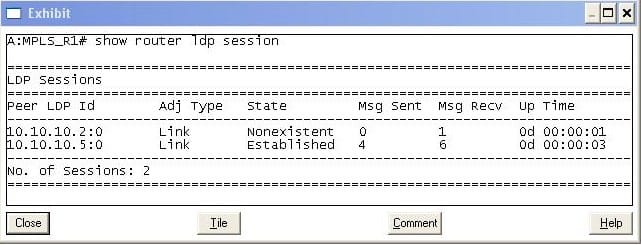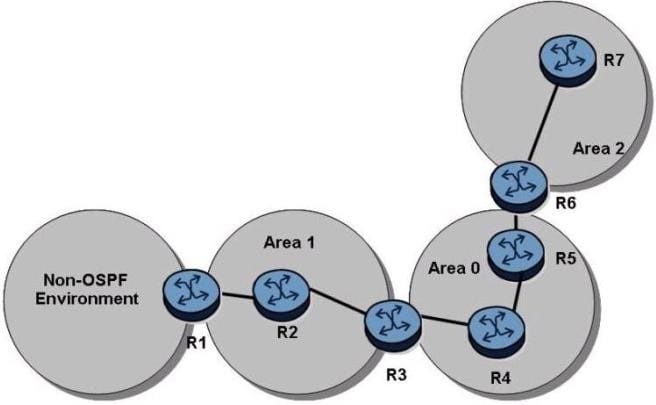Exam Details
Exam Code
:4A0-C01Exam Name
:Nokia NRS II CompositeCertification
:Nokia CertificationsVendor
:NokiaTotal Questions
:922 Q&AsLast Updated
:Apr 19, 2025
Nokia Nokia Certifications 4A0-C01 Questions & Answers
-
Question 691:
Router R3 signals an LSP, reserving 1Gbps bandwidth on a 10Gbps link. RSVP configuration limits reservable bandwidth to 20 percent on the egress interface. Which of the following statements is true?
A. The egress RSVP interface has 80 percent bandwidth unreserved.
B. LSPs can reserve an additional 9.9 Gbps bandwidth on this RSVP interface.
C. The head end reserves 100Mbps for the LSP
D. The egress RSVP interface has 1 Gbps bandwidth unreserved.
-
Question 692:
Click on the exhibit button below.

Under which condition might the peer LDP ID 10.10.10.2:0 entry show state "Nonexistent"?
A. When the interface to the peer router is down.
B. When router R1 has no route to the peer address 10.10.10.2.
C. When the adjacency between the two routers fails.
D. When the targeted session is not yet configured.
-
Question 693:
Which type of OSPF LSA has the following characteristics: It is flooded only within the area it originates from and can be originated by any OSPF router within the area (including non- DR routers).
A. Type 1 Router LSA
B. Type 2 Network LSA
C. Type 3 Summary LSA
D. Type 4 ASBR LSA
-
Question 694:
Which of the following statements regarding the last two octets of the LDP identifier is true?
A. It is always a random 16-bit number.
B. It is always zero for per-interface label space.
C. It is always non-zero.
D. It is always zero for per-platform label space.
E. It is always non-zero for per-platform label space.
-
Question 695:
An interface has a MAC address of 24-16-4d-16-b5-3d. What link-local address will be assigned to this interface?
A. fe80::2416:4dff:fe16:b53d
B. fe80::2616:4dff:fe16:b53d
C. ff80::2416:4dff:fe 16:b53d
D. ff80::2616:4dff:fe 16:b53d
E. fd80::2416:4dff:fe16:b53d
-
Question 696:
Which field of an IPv6 header indicates an upper layer protocol carried in the packet?
A. Next Header
B. Traffic Class
C. Flow Label
D. Payload Length
E. Options
-
Question 697:
In IS-IS, which of the following regarding an L1/L2 router is FALSE?
A. An L1/L2 router can have adjacencies with routers in different areas.
B. An L1/L2 router calculates separate SPF trees for the Level 1 and Level 2 topology.
C. An L1/L2 router advertises its L2 routes to other L1 routers in the same area.
D. An L1/L2 router sets the ATT bit in L1 LSPs to indicate that it has routes to other areas.
-
Question 698:
Click on the exhibit.

Which router is the designated router for the broadcast network?
A. 10.10.10.2
B. 10.10.10.3
C. 10.10.10.6
D. There is not enough information given to determine the designated router.
-
Question 699:
Which of the following is FALSE regarding link-state protocols?
A. Each router constructs its own link-state database with updates received from neighbors.
B. When a router performs an SPF computation, it sends the results to its neighbors.
C. An SPF computation is done by each router to determine the best path to destination prefixes
D. The link-state database is identical for all routers in a single area routing domain.
-
Question 700:
Click on the exhibit.

In the topology shown, router R1 is an ASBR configured to export external routes to OSPF. There are no stub or NSSA areas. Which of the following regarding LSAs is TRUE?
A. Router R3 will advertise Type 7 LSAs to Area 0 and Area 2.
B. Only routers R2 and R3 receive Type 5 LSAs advertised by router R1.
C. Router R2 will receive Type 5 and Type 7 LSAs.
D. Router R7 will receive Type 5 LSAs advertised by router R1.
Related Exams:
4A0-100
Nokia IP Networks and Services Fundamentals4A0-101
Nokia Interior Routing Protocols4A0-102
Nokia Border Gateway Protocol for Internet Routing4A0-103
Nokia Multiprotocol Label Switching4A0-104
Nokia Services Architecture4A0-105
Nokia Virtual Private LAN Services4A0-106
Nokia Virtual Private Routed Networks4A0-107
Nokia Quality of Service4A0-108
Nokia Multicast Protocols4A0-109
Alcatel-Lucent Triple Play Services
Tips on How to Prepare for the Exams
Nowadays, the certification exams become more and more important and required by more and more enterprises when applying for a job. But how to prepare for the exam effectively? How to prepare for the exam in a short time with less efforts? How to get a ideal result and how to find the most reliable resources? Here on Vcedump.com, you will find all the answers. Vcedump.com provide not only Nokia exam questions, answers and explanations but also complete assistance on your exam preparation and certification application. If you are confused on your 4A0-C01 exam preparations and Nokia certification application, do not hesitate to visit our Vcedump.com to find your solutions here.